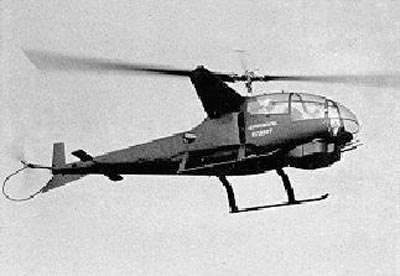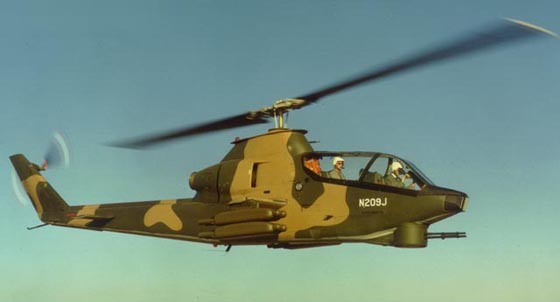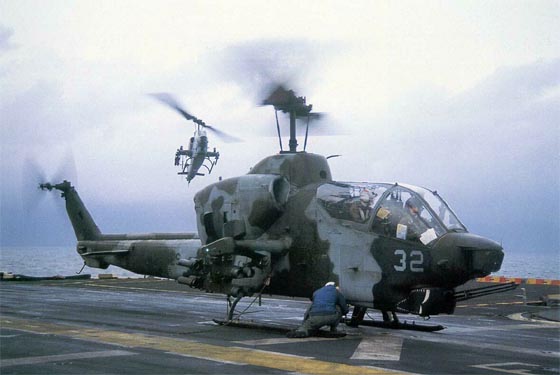WARBIRDS RESOURCE GROUP > VIETNAM > COBRA > PREVIOUS PAGE
Design & Development
The UH-1 made the theory of air cavalry practical, as the new tactics called for US forces to be highly mobile across a wide area. Unlike before, they would not stand and fight long battles, and they would not stay and hold positions. Instead, the plan was that the troops carried by fleets of Hueys would range across the country, to fight the enemy at times and places of their own choice.
It soon became clear that the unarmed UH-1 troop helicopters were vulnerable against ground fire from Vie^.t Co^.ng and NVA troops, particularly as they came down to drop their troops in a landing zone. Without friendly support from artillery or ground forces, the only way to pacify a landing zone was from the air, preferably with a machine that could closely escort the transport helicopters, and loiter over the landing zone as the battle progressed. By 1962 a small number of armed UH-1As were used as escorts, armed with multiple machine guns and rocket mounts.
The massive expansion of American military presence in Vietnam opened a new era of war from the air. The linchpin of US Army tactics were the helicopters, and the protection of those helicopters became a vital role.
Bell 207 Sioux Scout
Bell had been investigating helicopter gunships since the late 1950s and revealed a mockup of its helicopter gunship concept, named "Iroquois Warrior" in 1962. The design featured a long, slender body with stub wings and a two seat tandem cockpit. It was armed with a chin mounted grenade launcher. A 20 mm belly cannon and munition mount points on the stub wings were also planned.

The Sioux Scout had all the key features of a modern helicopter gunship – a tandem cockpit, stub wings for weapons, and a chin-mounted gun turret. After evaluating the Sioux Scout in early 1964, the Army was impressed, but also believed the Sioux Scout was too small, underpowered, unsophisticated, and fragile to be of practical use.
Advanced Aerial Fire Support System (AAFSS) competition
Army's solution to the shortcomings of the Sioux Scout was to launch the Advanced Aerial Fire Support System (AAFSS) competition.
The AAFSS requirement would give birth to the Lockheed AH-56 Cheyenne – a heavy battlefield helicopter that would prove to be over-ambitious, over-complex and over-budget, before being canceled 10 years later in 1972. The Cheyenne program developed future technology and demonstrated some impressive performance, but was never made to work as a functional gunship. It served to underline an important rule of the combat helicopter – survival would be ensured only by the right mix of speed, agility and weapons.
Model 209
At the same time, despite the Army's preference for the AAFSS – for which Bell Helicopter was not selected to compete – Bell stuck with their own idea of a smaller and lighter gunship. In January 1965 Bell invested $1 million to proceed with a new design.

In Vietnam, events were also advancing in favor of the Model 209. Attacks on US forces were increasing, and by the end of June 1965 there were already 50,000 US ground troops in Vietnam.
1965 was also the deadline for AAFSS selection, but the program was stuck in technical difficulties and political bickering. The U.S. Army needed an interim gunship for Vietnam and it asked five companies to provide a quick solution. Submissions came in for armed variants of the Boeing-Vertol ACH-47A, Kaman Kaman HH-2C Tomahawk, Piasecki 16H Pathfinder, Sikorsky S-61, and the Bell 209.
On 3 September 1965 Bell rolled out the prototype, and four days later it made its maiden flight, only eight months from the go-ahead. In April 1966, the Model 209 won an evaluation against the other rival helicopters. Then the Army signed the first production contract for 110 aircraft.
The Bell 209 demonstrator was used for the next six years to test weapons and fit of equipment. It had been modified to the match AH-1 production standard by the early 1970s. The demonstrator was retired to the Patton Museum at Fort Knox, KY and converted to approximately its original appearance.
Into production
The Bell 209 design was modified for production. The retractable skids were replaced by simpler fixed skids. A new wide-blade rotor was featured. For production, a plexiglass canopy replaced the 209's armored glass canopy which was heavy enough to harm performance.
By June 1967, the first AH-1G HueyCobras had been delivered. Bell built 1,116 AH-1Gs for the U.S. Army between 1967 and 1973, and the Cobras chalked up over a million operational hours in Vietnam.
The U.S. Marine Corps was very interested in the AH-1G Cobra, but preferred a twin-engined version for improved safety in over-water operations, and also wanted a more potent turret-mounted weapon. At first, the Department of Defense had balked at providing the Marines with a twin-engined version of the Cobra, in the belief that commonality with Army AH-1Gs outweighed the advantages of a different engine fit. However the Marines won out and awarded Bell a contract for 49 twin-engined AH-1J SeaCobras in May 1968. As an interim measure, the U.S. Army passed on 38 AH-1Gs to the Marines in 1969. The AH-1J also received a more powerful gun turret. It featured a three barrel 20 mm XM197 cannon that was based on the six barrel M61 Vulcan cannon.
The Marine Corps requested greater load carrying capability in high temperatures for the Cobra in the 1970s. Bell used systems from the Model 309 to develop the AH-1T. This version had a lengthened tailboom and fuselage with an upgraded transmission and engines from the 309. Bell designed the AH-1T to be more reliable and easier to maintain in the field. The version was given full TOW capability with targeting system and other sensors. An advanced version, known as the AH-1T+ with more powerful T700-GE-700 engines and advanced avionics was proposed to Iran in the late 1970s, but the overthrow of the Shah of Iran resulted in the sale being canceled.

The AH-1T+ demonstrator and AH-1W prototype was later tested with a new experimental composite four blade main rotor system. The new system offered better performance, reduced noise and improved battle damage tolerance. Lacking a USMC contract, Bell developed this new design into the AH-1Z with its own funds. By 1996, the Marines were again not allowed to order the AH-64. Developing a marine version of the Apache would have been expensive and it was likely that the Marine Corps would be its only customer. They instead signed a contract for upgrading 180 AH-1Ws into AH-1Zs.
The AH-1Z Viper features several design changes. The AH-1Z's two redesigned wing stubs are longer with each adding a wing-tip station for a missile such as the AIM-9 Sidewinder. Each wing has two other stations for 70 mm (2.75 in) Hydra rocket pods, or AGM-114 Hellfire quad missile launcher. The Longbow radar can be mounted on a wing tip station.
Sources:
Wikipedia: AH-1 Cobra
WARBIRDS RESOURCE GROUP > VIETNAM > COBRA > PREVIOUS PAGE
